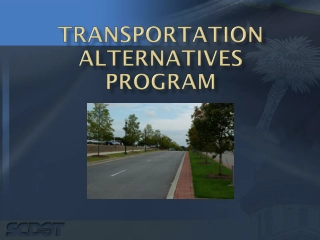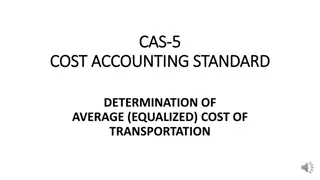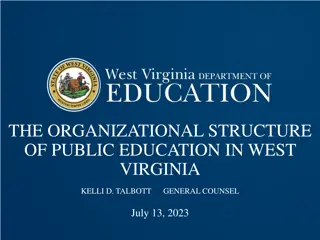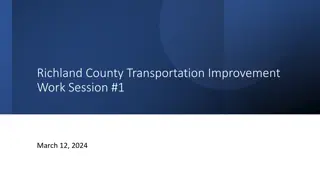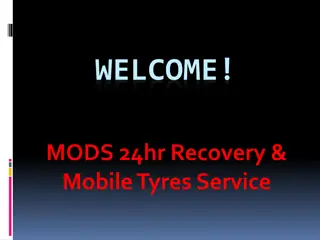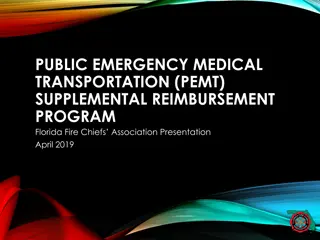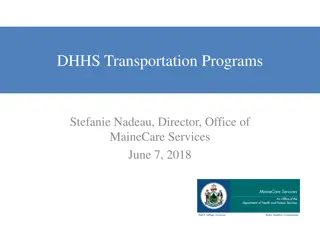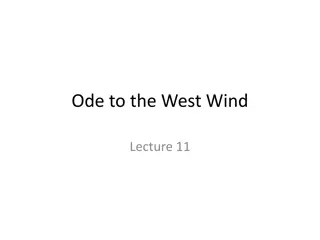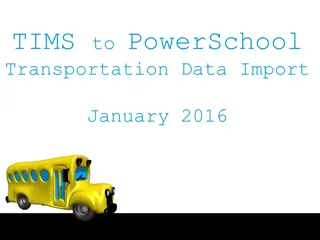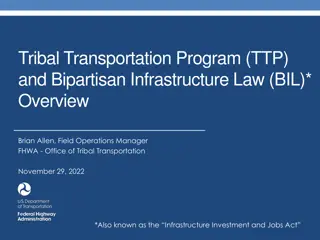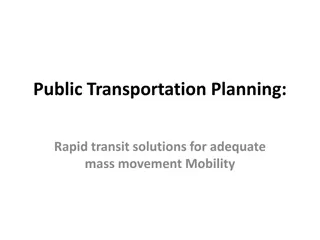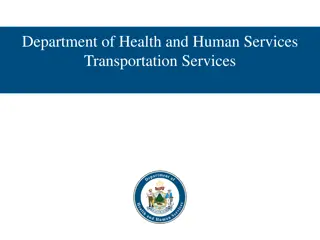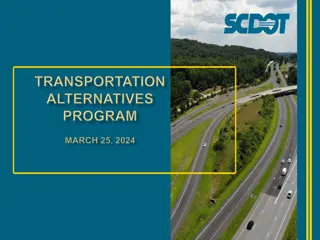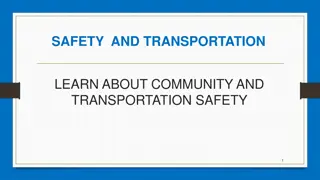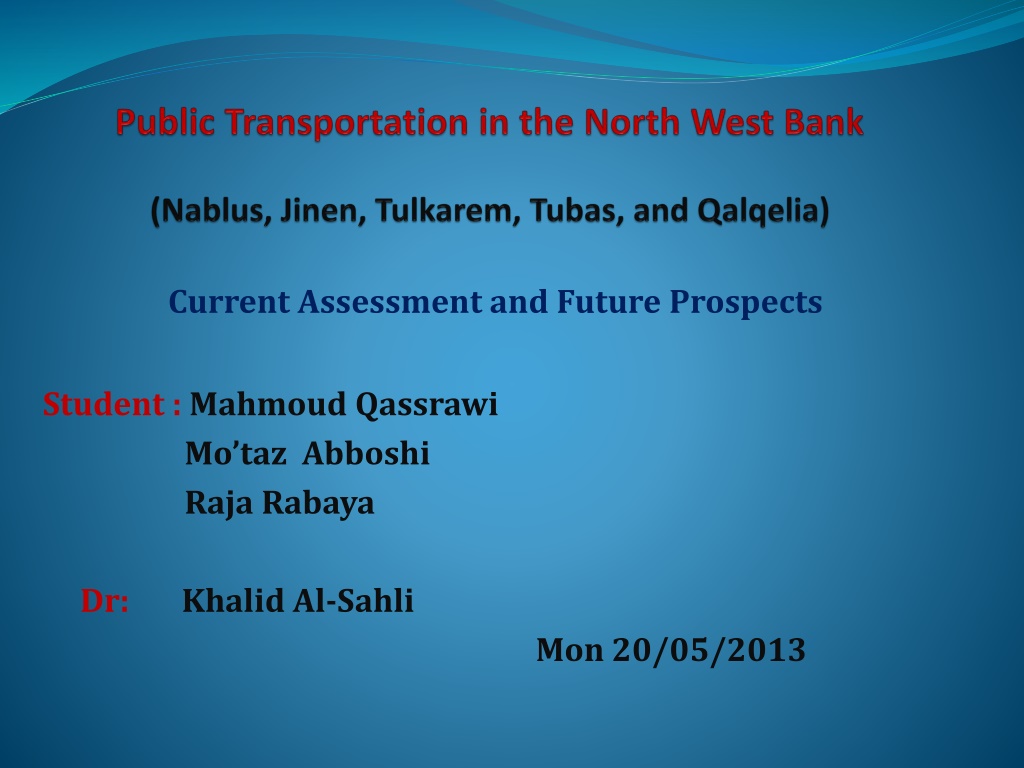
Analysis of Public Transportation System in Palestine
This research evaluates the current public transportation system in Palestine, highlighting issues such as the absence of laws, delays, pollution, and aging buses. The objective is to improve the efficiency and service quality of the public transport network through analyzing data collected from various parking complexes. The study focuses on average headway times for buses and shared taxis in different cities, with a goal to optimize the public transportation system for better user experience.
Download Presentation

Please find below an Image/Link to download the presentation.
The content on the website is provided AS IS for your information and personal use only. It may not be sold, licensed, or shared on other websites without obtaining consent from the author. If you encounter any issues during the download, it is possible that the publisher has removed the file from their server.
You are allowed to download the files provided on this website for personal or commercial use, subject to the condition that they are used lawfully. All files are the property of their respective owners.
The content on the website is provided AS IS for your information and personal use only. It may not be sold, licensed, or shared on other websites without obtaining consent from the author.
E N D
Presentation Transcript
Current Assessment and Future Prospects Student : Mahmoud Qassrawi Mo taz Abboshi Raja Rabaya Dr: Khalid Al-Sahli Mon 20/05/2013
Current situation Public transportation system in west bank face many problems as : The absence of laws Delay Pollution Age of buses, provided service is not satisfactory
The general objective of this research is to analyze and evaluate the current public transportation system, to find an optimal system of work of the public transport network, and mechanism of action between the companies concerned. solutions will, improve the public transport system, and to provide better service for users.
The evaluating and assessing the public transportation in Palestine, which requires accurate techniques of data collection. The date was collected from field work and meetings with some drivers and official workers in public transportation sector; the collected information was for each parking complex.
First type of data is the average headway for buses and shared taxis enter and leave the complexes in Nablus, Jenin, Tulkarem, Tubas, and Qalqelia ,and have been summarized in tables for each complex.
Average headway in one direction= (Number of work hours *60 minute) divided by (number of vehicles *average number of trips in that direction per day). Number of work hours= 10 hour or 12 hour , Depending on the size of the village and their need for the city
Average headway and number of vehicles entering the Western Public Transport Complex during the day(cities complex)
The average headway numbers give an indication that the demand is high on the shared taxis but not for the mini busses or the public busses, that s because the service provided by the shared taxis and, and the low headway, make the passengers use shared taxis as travelling method from the communities to the center of the other governorate.
Average headway and number of vehicles exiting the An-Nasra Public Transport Complex( in jenin) during the day
The average headway gives an indication that the demand and number of passengers is high between jenin city and this sample of villages , but it shows also that customers prefer in general the shared taxis to use more than mini busses and public busses.
Cost analysis for Busses and Shared Taxis Cost analysis require Other type of data collected as, the distance in Km between cities ,and date relevant to vehicle as fuel unit cost , fee, Insurance cost, registration cost, taxes, maintenance cost, and indirect cost, In addition to headway data.
Income per trip = # of passenger * Fee Income per vehicle per day = Income per trip* Total trips per vehicle Income per vehicle per month= Income per vehicle per day*25 days/month Fuel cost per trip= Fuel cost(NIS/km)* Distance(Km) Fuel cost per vehicle per month= Fuel cost per vehicle per day*25days/month Depreciation cost/month=(Initial price-salvage value)/# of year 12 months
Total cost per month= Average maintenance cost per month+ Insurance ®istration cost per month+ Depreciation cost/month+ Permit cost per month+ Fuel cost per vehicle per month Net Income per month= Income per vehicle per month- Total cost per month
Sample calculations of cost for some shared taxis routes between Nablus and some major cities.
The previous table represents the major routes between Nablus and the other cities, and shows the net income per month, which varies between 2000 NIS to more than 6000 NIS. These numbers are affected by the demand and the purpose of the journey; for example there is a very low demand between Jenin and Qalqelia so the passengers have an alternative route which is Nablus city.
Sample calculations of cost for some public busses(50 passengers)routes from Nablus governorate to other major cities.
The previous table show the cost analysis, for the routes between the major cities in the north of the West Bank, the demand is high due to the large population in this cities, which leads to high net income per month to the drivers and buses company. Study show that the most of these busses are old, but benefit show the ability to Renewal.
Proper Solutions Based on the study, the problems have several possible solutions, but there are no one solution for the all cases of the Public Transportation in the West Bank, so possible solutions were collected and made in a way to resolve the issues.
Possible solution renewal of public transport buses. renewal of public transport taxis. merge lines. and matters related to government.
Renewal of public transport buses Most of current busses are old buses (1986-1994), it a 20 years of service, so it consumes a high amount of diesel, and they are in unsatisfactory situation; no air condition, may break down at any time of travelling, also the passengers are not comfortable. The following table shows the cost analysis for old busses. Take busses of( Jinen-Nablus) as example
From the previous table we note that there is a large difference in profit; the newer buses get 39000 NIS more than the older one per year. Moreover, it provides a high quality of service. we have know that the buses (model 2000-2001) price is 110000 (NIS), and the buses (1986-1994) are evaluated in the range of (20000-30000) NIS.
If the companies decided to renew the busses 110000-25000= 85000 (NIS) company pays for replacing one bus. On the other hand, the profit increases by 39000 NIS/ year. Assume the newer one will work for 8 years, (from the difference between models for older & newer ones) Depreciation (110000-25000)/8= 10600 (NIS)/year The profit become 39000-10600 = 28400 NIS/year The returned year = 85000/28400 = 3 year Economically, this is a good process, also this will attract more passengers to use public busses.
Merge lines Oreef and Jamma een/Zeeta headway data for busses.
Total number of trips from Oreef and Jammaeen to eastern complex in Nablus = 4buss * 3 trips (Oreef) + 5 busses *6 trips (Jamma een/Zeeta)=42 trip Total number of trips from eastern complex in Nablus to Oreef and Jamma een= 4buss * 3 trips (Oreef) + 5 busses *4 trips (Jamma een.Zeeta)= 32 trip
The average headway of vehicles entering the eastern complex, from Oreef and Jamma een, after merging the two lines : 12 (hour) * 60 (minute) / 42 trip = 17.15 minutes The average headway of vehicles leaving the eastern complex, from Oreef and Jamma een, after merging the two lines: 12 (hour) * 60 (minute) / 32 trip = 22.5 minutes
Issues Related to Government Fuel cost: the fuel cost is very high and this reduces the possibility of the public transportation companies to competition and providing a good service. Road network: the inappropriate road network is the main reason for not renewal the public transportation vehicles, a good road network not only helps in reducing the maintenances cost but it reduces the operating cost as well.
Taxes: reduce the taxes and other expenses to open the way to the public transportation companies to reduce the ticket price and improve the services, thus attracting more ridership. Apply the low : as the allotted age of vehicle and Redistribution of franchise lines
Recommendations Study the capacity of current complexes to carry the volume of movement, and the possibility of establishing new complexes because we noticed during our study that some complex are crowed and serve more than 20 lines. Study the fuel consumption and air pollution increase resulted from distraction of people from using public transportation, and using their carsinstead. Revaluate the lines and design of routes that connect between communities.
Improve the road safety systems. Feasibility studies related to the renewal the current buses. Explore the option of establishing a Railway system between major governorates. Study the working principles of Transportation Companies, and how to improve the industry for the companies and the people.

